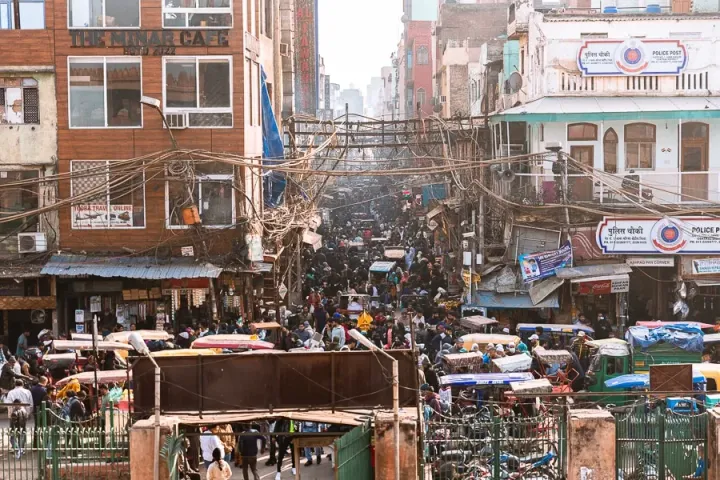Kucha Ustad Hamid: A Hidden Gem in Old Delhi
Kucha Ustad Hamid is a lesser-known yet historically significant area nestled in the bustling streets of Old Delhi. This charming lane, rich in history and culture, offers a unique glimpse into the architectural and artistic heritage of the Mughal era.
This article explores the history, significance, modern relevance, attractions, and practical tips for visiting Kucha Ustad Hamid, making it a must-visit for travelers seeking to experience the authentic essence of Old Delhi.
Who was Ustad Hamid?
Kucha Ustad Hamid is named after Ustad Hamid, a distinguished Persian architect who played a pivotal role in the construction of some of the most iconic structures in Delhi, including the Red Fort and the Taj Mahal. Ustad Hamid was renowned for his architectural prowess during the Mughal era, and his legacy continues to resonate in the intricate designs and structures that define the area.
Ustad Hamid's Contributions to Old Delhi
- Architectural Mastery: Ustad Hamid was instrumental in the construction of several significant structures in Shahjahanabad, which is now known as Old Delhi. His work exemplified the intricate design and grandeur characteristic of Mughal architecture.
- Red Fort: One of his most notable contributions was to the Red Fort, a UNESCO World Heritage Site and a symbol of India's rich history. The fort served as the main residence of the Mughal emperors and is renowned for its stunning architecture, which includes massive walls, beautiful gardens, and intricate carvings. Ustad Hamid's expertise in design played a crucial role in shaping the fort's iconic features.
- Cultural Legacy: Beyond the physical structures, Ustad Hamid's work contributed to the cultural fabric of Old Delhi. The architectural styles he employed influenced subsequent generations of builders and artisans, fostering a rich tradition of craftsmanship that continues to thrive in the area.
- Kucha Ustad Hamid: The area named after him, Kucha Ustad Hamid, reflects his legacy. This lane is part of the historic Chandni Chowk area and is characterized by its havelis and vibrant street life. It serves as a reminder of the artistic and architectural achievements of the Mughal era.
- Artisan Influence: Ustad Hamid's contributions also extended to the local artisan community. The skills and techniques developed during his time have been passed down through generations, ensuring that the craftsmanship associated with Mughal architecture remains alive in Old Delhi today.
ArchitecturalSignificance of Kucha Ustad Hamid
Historically, Kucha Ustad Hamid was a vibrant residential area that housed artisans, craftsmen, and merchants. The lane is characterized by its narrow alleys, traditional havelis (mansions), and bustling markets, which reflect the rich cultural tapestry of Old Delhi. Over the years, the area has witnessed various transformations, particularly after the Revolt of 1857, which led to significant changes in the urban landscape of Delhi.
Kucha Ustad Hamid holds immense significance as a testament to the architectural brilliance of the Mughal period. The area is not only a reminder of Ustad Hamid's contributions to Indian architecture but also serves as a living museum of the lifestyle and traditions of the people who once inhabited this vibrant neighborhood.
The lane is also notable for its connection to the arts and crafts of Old Delhi. Many artisans still practice traditional crafts, such as pottery, weaving, and metalwork, preserving the skills and techniques passed down through generations. This cultural continuity adds to the charm of Kucha Ustad Hamid, making it a valuable destination for those interested in exploring India's rich artistic heritage.
Kucha Ustad Hamid Tourism: Modern Relevance
In contemporary times, Kucha Ustad Hamid has become a focal point for cultural tourism in Old Delhi. The area attracts visitors who are keen to experience the authentic atmosphere of the old city, away from the more commercialized tourist spots.
Several initiatives have been undertaken to preserve the heritage of Kucha Ustad Hamid, including restoration projects for the havelis and promotion of local crafts. These efforts aim to revitalize the area while maintaining its historical integrity, ensuring that future generations can appreciate its cultural significance.
Kucha Ustad Hamid Attractions
While Kucha Ustad Hamid may not be as widely known as other attractions in Old Delhi, it offers several unique experiences for visitors:
Architectural Heritage
The havelis in Kucha Ustad Hamid showcase intricate Mughal architecture, with ornate facades, jali work (lattice screens), and beautiful courtyards. Exploring these structures provides insight into the architectural styles of the time.
Local Artisans
Visitors can interact with local artisans who continue to practice traditional crafts. This offers a unique opportunity to witness the craftsmanship firsthand and purchase authentic handmade products.
Street Food
Kucha Ustad Hamid is in close proximity to some of Old Delhi's famous street food stalls. Travelers can indulge in local delicacies, such as chaat, kebabs, and sweets, immersing themselves in the culinary heritage of the area.
Cultural Events
Occasionally, Kucha Ustad Hamid hosts cultural events, including music and dance performances, showcasing the rich artistic traditions of Delhi. These events provide a vibrant atmosphere and a chance to engage with the local community.
How to Get There
By Metro
The nearest metro station to Kucha Ustad Hamid is Chandni Chowk on the Yellow Line. From the metro station, visitors can either walk to Kucha Ustad Hamid or take a rickshaw for a short ride through the narrow lanes of Old Delhi.
By Bus
Delhi's extensive bus network connects various parts of the city, including Old Delhi. Travelers can take a bus to Chandni Chowk orDelhi Gate, both of which are within walking distance of Kucha Ustad Hamid.
By Taxi
Taxis and ride-sharing services like Uber and Ola are readily available in Delhi. Visitors can book a ride to Kucha Ustad Hamid, providing a convenient option for those unfamiliar with the city's public transport system.
Entry and Timings
Kucha Ustad Hamid does not have an official entry fee, as it is a public area. Visitors can explore the lane at their leisure. However, they should be respectful of the privacy of residents and avoid entering private homes or properties without permission.
Best Time to Visit
The best time to visit Kucha Ustad Hamid in Old Delhi is during the cooler months, from October to March. Here's what to expect during these periods:
October to November
These months mark the transition from the monsoon season to winter. The weather is pleasant, with temperatures ranging from 20°C to 30°C (68°F to 86°F), making it comfortable for exploring the bustling streets and historical sites.
December to February
This is winter in Delhi, with cooler temperatures averaging between 7°C to 20°C (45°F to 68°F). The weather is generally dry, and it’s a great time for sightseeing. However, mornings can be foggy, so plan your visits accordingly.
March
March marks the beginning of spring, with temperatures ranging from 15°C to 25°C (59°F to 77°F). The weather is pleasant, and it's a great time to explore the area before the summer heat sets in.
Practical Considerations
- Crowds: October to March is peak tourist season, especially around festivals like Diwali (October/November) and Christmas. Expect larger crowds, particularly in popular areas like Chandni Chowk.
- Events: The winter months often feature various cultural festivals and events, enhancing the experience of visiting historical sites.
- Clothing: Dress in layers during winter, as temperatures can drop significantly in the evenings. Comfortable walking shoes are essential for navigating the narrow lanes of Kucha Ustad Hamid.
- Accommodation: Book your accommodation in advance, as hotels can fill up quickly during peak tourist season.
Practical Tips for Travelers
- Dress Comfortably: Wear comfortable clothing and shoes, as you will be walking through narrow and sometimes uneven streets.
- Stay Hydrated: Carry water with you, especially during warmer months, to stay hydrated while exploring.
- Plan Your Visit During Off-Peak Hours: To avoid large crowds and enjoy a more peaceful experience, consider visiting the lane during off-peak hours, such as early mornings or late afternoons.
- Be Cautious of Traffic: The streets of Old Delhi can be congested with vehicles and pedestrians. Exercise caution while navigating the lanes.
- Bargain Wisely: If shopping for local crafts, be prepared to negotiate prices, as haggling is common in markets.
- Respect Local Customs: Be mindful of local customs and traditions, especially when visiting religious sites like Jama Masjid.
- Etiquette: It's always good to ask before taking pictures of locals or their work.
- Explore with an Open Mind: Old Delhi is a sensory overload of sights, sounds, and smells. Embrace the chaos and enjoy the unique experiences it offers.
Nearby Places to Explore
Red Fort
A short distance from Galli Guliyan, the Red Fort is a UNESCO World Heritage site and a symbol of India's rich history. Explore its magnificent architecture and learn about its significance in India's struggle for independence. The fort hosts a sound and light show in the evenings, narrating the history of Delhi.
Chandni Chowk Market
One of Delhi's oldest and busiest markets, Chandni Chowk offers a sensory overload of sights, sounds, and smells. From street food to traditional garments, this market is a must-visit. Don't miss out on the famous Paranthe Wali Gali, where you can savor a variety of stuffed parathas.
Fatehpuri Masjid
Located at the western end of Chandni Chowk, Fatehpuri Masjid is another beautiful mosque built during the Mughal era. Its serene environment provides a stark contrast to the bustling market outside. The mosque is an architectural marvel, with its intricate carvings and spacious courtyard.
Paranthe Wali Gali
A famous lane in Chandni Chowk known for its variety of paranthas (stuffed flatbreads). This foodie paradise is a must-visit for anyone looking to indulge in traditional Delhi cuisine. The paranthas are served with a variety of accompaniments, including chutneys, pickles, and curries.
Sis Ganj Gurudwara
A significant Sikh shrine, Sis Ganj Gurudwara is located near Chandni Chowk. The gurudwara commemorates the martyrdom of Guru Tegh Bahadur, the ninth Sikh Guru. It's a place of peace and spirituality, offering a calm respite from the hustle and bustle of the market.
Chunnamal Haveli
Located in the heart of Chandni Chowk, Chunnamal Haveli is one of the few remaining grand havelis of Old Delhi. It showcases the opulence of the 19th century and offers a peek into the lifestyle of the wealthy merchant class of that era.
Khari Baoli
Khari Baoli, nestled in Old Delhi, is Asia’s largest spice market, offering a vibrant sensory experience. Bursting with colorful spices, dried fruits, and herbs, this bustling bazaar is a must-visit for culinary enthusiasts and those seeking an authentic slice of Delhi’s rich trading heritage.
Kinari Bazaar
Kinari Bazaar in Old Delhi is a bustling marketplace renowned for its glittering wedding decorations, vibrant fabrics, and intricate trimmings. This lively bazaar is a haven for brides-to-be and craft enthusiasts, offering an array of ornate ribbons, laces, and traditional embellishments, capturing the essence of Indian celebrations.
The Timeless Charm of Kucha Ustad Hamid
If you're ever in Old Delhi - be it for leisure or business - quickly walk by the lane of Kucha Ustad Hamid. Steeped in rich history and cultural significance, the area is not only a testament to the craftsmanship of the past but also serves as a living reminder of the stories and trades that once flourished here. So come, explore, and let Kucha Ustad Hamid's unique allure leave you with unforgettable memories. Your adventure in Old Delhi awaits!




Comments ()